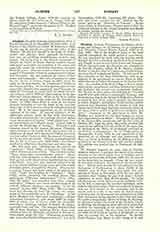

Plumier, CHARLES (botanical abbreviation, Plum.), French botanist, b. at Marseilles, April 20, 1646; d. at Puerto de Sta Maria near Cadiz, November 20, 1704. At the age of sixteen he entered the order of the Minims. He devoted himself to the study of mathematics and physics, made physical instruments, and was an excellent draughtsman, painter, and turner. On being sent to the French monastery of Trinity, dei Monti at Rome, Plumier studied botany with great zeal under two members of the order, and especially under the well-known Cistercian botanist, Paolo Boccone. After his return to France he became a pupil of Tournefort, whom he accompanied on botanical excursions. He also explored the coasts of Provence and Languedoc. His work, of permanent value for the science of botany, began in 1689, when, by order of the government, he accompanied Surian to the French Antilles. As this first journey proved very successful, Plumier was appointed royal botanist; in 1693, by command of Louis XIV, he made his second journey, and in 1695 his third journey to the Antilles and Central America. While in the West Indies he was greatly aided in his work by the Dominican Labat. In 1704, when about to start on his fourth journey, intending to visit the home of the true cinchona tree in Peru, he was taken ill with pleurisy and died. He is the most important of the botanical explorers of his time. All natural scientists of the eighteenth century spoke of him with admiration. According to Cuvier he was “perhaps the most industrious investigator of nature”, while Haller said, “vir ad incrementum rei herbariae natus” (a man born to extend the knowledge of botany). Tournefort and Linnmus named in his honor the genus Plumeria, which belongs to the family of the Apocynacece and is indigenous in about forty species to Central America; it is now called Plumiera, with the name of Plumieroidece for its first sub-family. Plumier accomplished all that he did in fifteen years (1689-1704); his labors resulted in collections, descriptions, and drawings.
His first work was, “Description des plantes de l’Amerique” (Paris, 1693); it contained 108 plates, half of which represented ferns. This was followed by “Nova plantarum americanarum genera” (Paris, 1703-04), with 40 plates; in this work about one hundred genera, with about seven hundred species, were redescribed. At a later date Linnaeus adopted in his system, almost without change, these and other newly described genera arranged by Plumier. Plumier left a work in French and Latin ready to be printed entitled “Traite des fougeres de l’Amerique” (Paris, 1705), which contained 172 excellent plates. The publication “Filicetum Americanum” (Paris, 1703), with 222 plates, was compiled from those already mentioned. Plumier also wrote another book of an entirely different character on turning, “L’Art de tourner” (Lyons, 1701; Paris, 1749); this was translated into Russian by Peter the Great; the manuscript of the translation is at St. Petersburg. At his death Plumier left thirty-one manuscript volumes containing descriptions, and about 6000 drawings, 4000 of which were of plants, while the remainder reproduced American animals of nearly all classes, especially birds and fish. The botanist Boerhave had 508 of these drawings copied at Paris; these were published later by Burmann, Professor of Botany at Amsterdam, under the title: “Plantarum americanarum, quas ohm Carolus Plumierus detexit”, fasc. I—X (Amsterdam, 1755-60), containing 262 plates. Plumier also wrote treatises for the “Journal des Savants” and for the “Memoires de Trevoux”. By his observations in Martinique, Plumier proved that the cochineal belongs to the animal kingdom and should be classed among the insects.
JOSEPH ROMPEL

